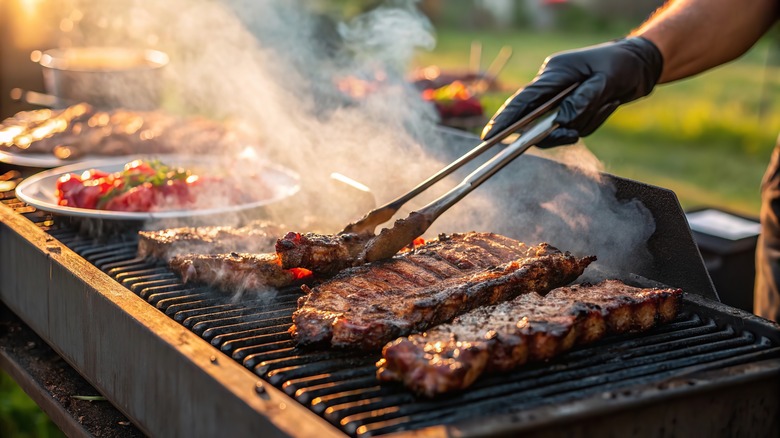The Temperature Mistake You're Making When Grilling Meat
When using a piping hot grill, it's natural to think that there's enough radiant heat to properly warm a steak through while it's outside achieves a perfect sear. However, Nicole Johnson, the owner, photographer, and recipe developer at Or Whatever You Do, explained that it might be time to rethink this idea.
"Meat that goes straight from the fridge to the grill cooks unevenly," Johnson told Food Republic. "The outside sears fast while the inside stays cold, so by the time the middle is safe to eat, the outside's overcooked." Cooking steak from cold is never a great idea, even if you like your beef extra rare, but it's an even worse one when you cook pork or chicken. A crucial mistake everyone makes with chicken is cooking it right out of the fridge — unlike red meat, chicken must reach a safe temperature of 165 degrees Fahrenheit, and pork has to hit at least 145 degrees Fahrenheit to be edible.
"Letting meat sit at room temp for 20 to 60 minutes (depending on the cut) helps it cook more evenly, keeps moisture locked in, and improves texture," Johnson continued. "Skipping that step can lead to dry edges, undercooked centers, or meat that seizes up and toughens." This is a bit of a balancing act as you only want to leave meat out for the bare minimum time it needs to avoid developing bacteria.
How long to let different meats sit at room temperature
When it comes to how long to let meat sit out, Nicole Johnson shared that the exact type of protein isn't the most important factor. "Size and thickness make all the difference here," the expert said.
"20 minutes is a general baseline for smaller cuts like chicken breasts, burgers, or thinner steaks," Johnson explained. "Larger cuts like bone-in ribeyes, pork chops, or whole spatchcocked chicken benefit from 30 to 60 minutes out of the fridge. You want the chill off, not warm meat." Learning how to properly use a meat thermometer is your best bet for getting the timing right and saving yourself from guesswork.
While a few degrees in either direction may not seem like a huge deal, it all depends on what exactly you're grilling. Fish is particularly delicate and has a narrow window of temperature perfection to achieve the best taste and texture. If you use a particularly sugary marinade, firmer meats like chicken or pork will also need precise timing to avoid burning the sugar and making it bitter. Even if you're using the highest-quality meat thermometer on the market, knowing how to use it properly and learning how to calibrate it will save you tons of headache and guarantee some great grilling.


